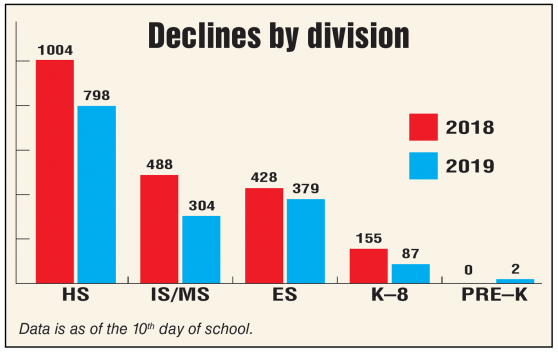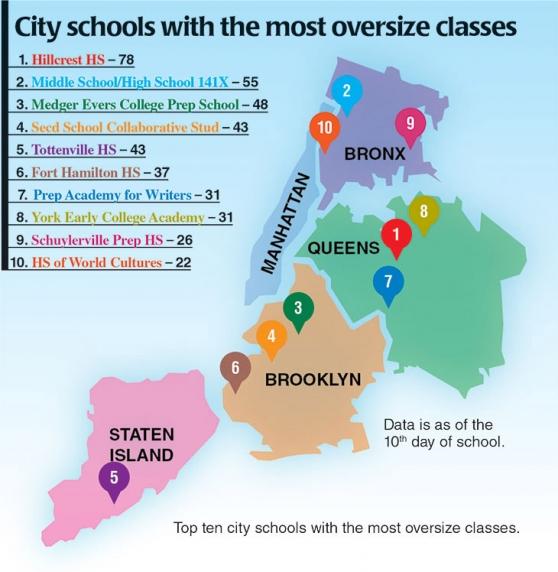New provisions speed class-size reductions

Teachers across the city got relief from oversize classes this fall at a faster pace than ever before — thanks to new class-size reduction provisions negotiated as part of the 2018 Department of Education-UFT contract and implemented citywide in September.
“This looks like our most effective tool so far in knocking down the problem of oversize classes,” said UFT President Michael Mulgrew. “The new process we negotiated in the 2018 contract has empowered our chapter leaders to create a better teaching and learning environment in our schools.”
By Day 10 of the new school year, there were 350 schools with a total of 1,570 oversize classes, down from more than 400 schools and more than 2,000 oversize classes at the same time last year. But in addition, thanks to a new procedure that empowered local superintendents and UFT district representatives to intervene, by the middle of October, 70 percent of the remaining schools with oversize classes had eliminated them. As of Oct. 18, only 83 schools with no history of chronic classsize problems had classes reported as oversize.
The DOE-UFT contract sets strict class-size limits [see chart]. Principals have 10 school days to reduce the numbers in classes that exceed these contractual limits. Under the previous process, those classes that remained oversize on Day 10 went directly to arbitration. Since an arbitrator heard the cases of five schools a day, it took months to address all the overages. The new streamlined resolution process on Day 10 hands the matter over to the relevant UFT district representative and superintendent, who have 10 days to come up with solutions for their district. Any overages not resolved by Day 21 go before a central labor-management committee on class size. If that committee can’t come up with a remedy, the issue goes to arbitration. The arbitrator’s remedy must be implemented within 10 days of the arbitration hearing.
“Under the old system, the union would have to rely on contract arbitration for the hundreds of schools that were out of compliance,” said Mulgrew. “The new agreement has meant that we will now have to go to arbitration on fewer than one hundred schools — and that number drops every day.”
In the new process, superintendents can intervene to make sure principals bring the class sizes into line. Staten Island District Representative Sean Rotkowitz said he and the District 31 superintendent resolved some oversize classes by assigning additional paraprofessionals for each instructional period.
In years past, Rotkowitz said, some Staten Island teachers with oversize classes had to wait until late April to have their cases heard by an arbitrator. This year was different. “The superintendent and his staff took the process seriously,” he said. “It allowed us to effectively and expeditiously conclude the matter in October, and we did it collaboratively.”
Schools with a history of oversize classes also got faster relief. Under the new contract rules, the citywide Class Size Labor-Management Committee must meet and come up with a school-specific resolution by Day 10 for schools with classes that have had oversize classes in four of the past six years. If the committee cannot resolve the issue, the case is scheduled for expedited arbitration as soon as 10 days later — and no later than the 34th school day of the term. The arbitrator can issue a binding remedy within five school days that the DOE must implement in five school days. Under the previous contract rules, the arbitration process often resulted in DOE “action plans” that provided little or no relief.
Out of 113 chronically out-of-compliance schools, 51 had no oversize classes by the second week of October, according to the UFT Grievance Department.
District 31 Special Representative Donna Coppola said her district’s superintendent worked with the union to try to come up with solutions for schools with chronic challenges.
“There was a lot of conversation with the superintendent to figure things out,” she said. “In one case, for example, we gave a school two extra prep periods a week to deal with the larger classes.”
When chronically out-of-compliance schools had to go to arbitration, their hearings were scheduled quickly, she added.
Dino Sferrazza, the chapter leader at Cardozo HS in Bayside, Queens, said his chronically out-of-compliance school got relief this year when the principal hired about 20 more teachers and added classes. The school year opened at Cardozo HS with 125 oversize classes — down from the usual 400 to 500 oversize classes, he said.
“We got all of them to contractual limits within 10 days at the school level,” Sferrazza said. “The process encouraged greater collaboration between the principal and the chapter leader.
